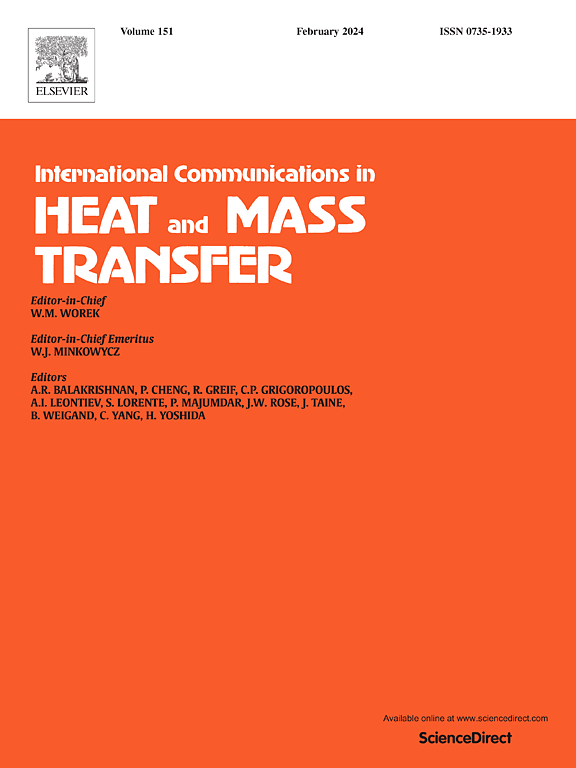用一种新的两相数值模型来评估抛物线槽式直接蒸汽收集器吸收管内的热危机
IF 6.4
2区 工程技术
Q1 MECHANICS
International Communications in Heat and Mass Transfer
Pub Date : 2025-05-16
DOI:10.1016/j.icheatmasstransfer.2025.109049
引用次数: 0
摘要
根据电力生产进一步脱碳的需要和促进可再生能源的使用,本文提出了用于朗肯循环内蒸汽产生的抛物槽收集器(PTC)的稳态准二维均匀平衡模型。考虑到传热流体(HTF)作为过冷液体进入吸收器,达到饱和温度,然后经历相变,集热器的热行为已经建模。目前还没有模型可以预测膜干现象的发生,并准确地模拟这种流动状态下的传热。在这项工作中,两相区域通过假设一个环形流动模式来建模,随后是一个可能的分散液滴流动模式,以描述即使在热危机条件下集热器的热行为。此外,该模型允许确定吸收器的内部特性,以确定收集器的静态稳定条件。热模型使用西班牙Almeria平台的直接太阳能蒸汽测试设施的实验数据进行了验证。以直接蒸汽发生(DSG)系统中的PTC为例进行了分析,并通过改变主要运行参数(直接法向辐照度、HTF质量流量和吸收器长度)进行了参数分析,以评估干干对集热器能量性能的影响。结果表明,效率在72.9% ~ 66.5%之间,并进一步强调,在典型的太阳能应用热通量范围内,热危机的发生不会导致破坏性现象。事实上,虽然壁温突然升高,但达到的值是可控的,使吸收器能够安全工作。本文章由计算机程序翻译,如有差异,请以英文原文为准。
A novel two-phase numerical model for evaluating thermal crisis in the absorber tube of a parabolic trough collector for direct steam generation
In line with the need for further decarbonization of electricity production and to promote the use of renewable energy sources, this article proposes a steady-state quasi 2-D homogeneous equilibrium model for a parabolic trough collector (PTC) intended for steam generation within a Rankine cycle. The thermal behaviour of the collector has been modelled considering that the heat transfer fluid (HTF) enters the absorber as subcooled liquid, reaches saturation temperature, and then undergoes phase change. No models are currently available that can predict the onset of the film dryout phenomenon and accurately simulate heat transfer under this flow regime. In this work the two-phase region has been modelled by assuming an annular flow regime, followed by a possible dispersed droplet flow pattern, to describe the thermal behaviour of the collector even under thermal crisis conditions. Furthermore, the model allows for the determination of the internal characteristics of the absorber to identify the static stability conditions of the collector. The thermal model was validated using experimental data from the Direct Solar Steam Test Facility at the Almeria platform (Spain). A case study of a PTC operating in a direct steam generation (DSG) system has been analyzed, and a parametric analysis was conducted by varying the main operating parameters (Direct Normal Irradiance, HTF mass flow rate, and absorber length) to assess the effect of dryout on the energy performance of the collector. The results show that the efficiency ranges between 72.9 % and 66.5 %, and furthermore, highlight that, within the range of thermal fluxes typical of solar applications, the onset of a thermal crisis does not lead to destructive phenomena. In fact, although the wall temperature increases suddenly, the values reached are contained, allowing the absorber to work safely.
求助全文
通过发布文献求助,成功后即可免费获取论文全文。
去求助
来源期刊
CiteScore
11.00
自引率
10.00%
发文量
648
审稿时长
32 days
期刊介绍:
International Communications in Heat and Mass Transfer serves as a world forum for the rapid dissemination of new ideas, new measurement techniques, preliminary findings of ongoing investigations, discussions, and criticisms in the field of heat and mass transfer. Two types of manuscript will be considered for publication: communications (short reports of new work or discussions of work which has already been published) and summaries (abstracts of reports, theses or manuscripts which are too long for publication in full). Together with its companion publication, International Journal of Heat and Mass Transfer, with which it shares the same Board of Editors, this journal is read by research workers and engineers throughout the world.

 求助内容:
求助内容: 应助结果提醒方式:
应助结果提醒方式:


